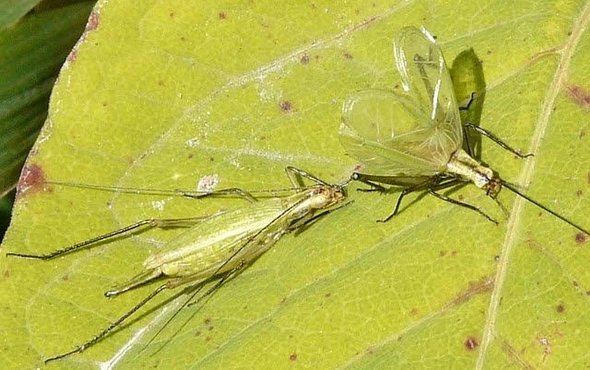This is Scientific American — 60-Second Science. I'm Jason G. Goldman.
Not too long ago we thought that only humans could make and use tools. Then Jane Goodall watched a chimpanzee called David take a small twig, snap the leaves off, stick it into a termite mound, and lick the insects off the stick. Seems some animals also made and used tools.
That observation was in 1960. Since then the club of tool users has expanded to include a wide range of primates, birds, marine mammals, and others. And now: an insect. Maybe.
Tree crickets use sound to attract mates. And they also fashion and use "baffles"—sound controllers—made of leaves to produce sound more efficiently. It's a behavior that's been known since at least 1975, but nobody ever really tried to figure out out how and why the bugs use the baffles.
"The way that tree crickets sing is to raise their wings and vibrate their wings back and forth. This causes sound to come off each surface of the wing, the front face of the wing and the back face of the wing."
University of Toronto biologist Natasha Mhatre.
But sound waves coming off the front of the wings and the sound waves coming off the back of the wings are out of phase with each other. The two sounds interfere with each other, making the call quieter.

To make a baffle, the cricket carves a small hole in the center of a leaf and sticks its body halfway through. The baffle absorbs sound coming from the back of the wings, and therefore lets the sounds coming from the front sides to come through loud and clear.
"And this prevents what we call acoustic short-circuiting, and therefore they make more sound."
But do these structures count as tools?
Mhatre weighed the behavior against the most recent definition for tool use described in the scientific literature. And based upon the requirements of that definition, it would seem that tree crickets do indeed make and use tools. The findings are in the journal Ethology.
So what does this discovery mean for the link between tool use and animal smarts?
"I don't know if I want to say it exactly this way but it actually takes tool use down a notch. Because if you see tool use in an animal, you can't immediately say the animal is smart. Even if you see optimal tool use in the animal, you can't say, well that's a really clever animal. Because actually that could be an inherited behavior."
Thanks for the minute for Scientific American — 60-Second Science. I'm Jason G. Goldman.











